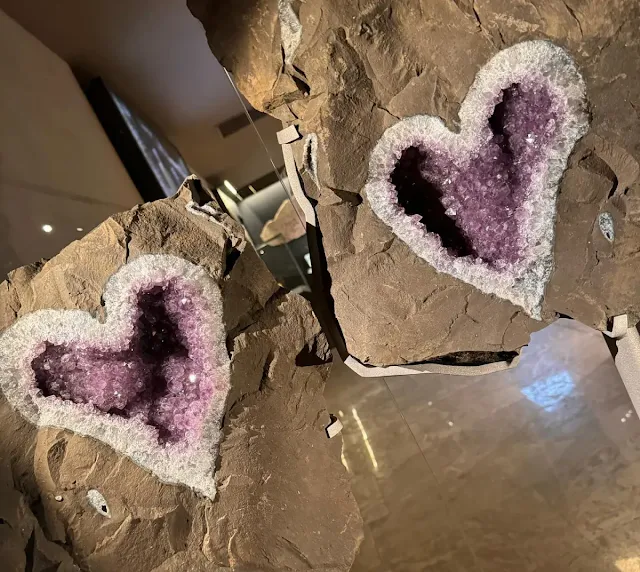The Coolest Rocks Ever Found
Among the coolest rocks ever discovered, some stand out for their unique colors, shapes, and patterns that make them appear almost too perfect to be natural.
The Heart-Shaped Amethyst Geode dazzles with its vibrant purple crystals, while the fiery hues of the Sunset Fire Opal mimic a sunset. The quirky Cookie Monster Agate looks like a cartoon face, and Chalcedony on Chrysocolla Stalactites impress with their otherworldly blue-green patterns. Pineapple Opal and Calcite Rose both evoke organic beauty with petal-like layers, and the Happy Thunderegg Agate adds a playful, smiley touch. Each of these stones is a small wonder, showcasing the artistry hidden within the earth.
These incredible finds remind us of the hidden wonders waiting to be discovered beneath our feet.
These rocky marvels come in a dazzling spectrum of colors, shapes, and sizes, hiding in the most unexpected corners of the globe. From heart-stopping amethyst geodes that crack open to reveal glittering purple caverns, to opals that shimmer with an entire rainbow trapped within, Earth's hidden treasures rival any cut gem. These aren't just rocks - they're time capsules, alien landscapes, and natural works of art all rolled into one.
7 Coolest Rocks on Earth
Heart-Shaped Amethyst Geode
 |
Heart-Shaped Amethyst Geode |
While countless heart-shaped gems are crafted for Valentine’s Day gifts, this amethyst geode needed no carving or polishing. When miners cracked it open, they uncovered a natural heart formed by Mother Earth herself. This remarkable discovery was made at the Santa Rosa mine in the Catalan area of Artigas, near the border with Brazil. The mine, operated by Uruguay Minerals, had just begun operations in the rugged basalt terrain when the miners stumbled upon this unique gem.
Upon splitting open a rock, they were amazed to find a beautiful, purple heart on each side of the geode. This natural wonder is a testament to the incredible beauty that can be found in nature without the need for human intervention.
The discovery serves as a reminder that the Earth has many hidden treasures waiting to be uncovered, and that the work of miners can sometimes lead to astonishing finds that captivate the imagination.
Sunset Fire Opal
 |
| Sunset Fire Opal from Mexico. Photo: Jeff Schultz |
The stunning fire opal showcases vibrant orange and yellow colors, and the play of light creates a mesmerizing resemblance to a sunset. The cloudy formations within the stone further enhance the illusion of a fiery sky. Fire opal is a type of opal that exhibits a vibrant orange or red color due to the presence of iron oxide. It forms under specific geological conditions, where silica-rich water seeps into cavities and deposits layers of opal. The unique arrangement of colors and patterns within this opal creates a striking resemblance to a fiery sunset, complete with clouds and a glowing horizon. This is a result of the interplay of light with the opal's internal structure.
Cookie Monster Agate
 |
| A rock collector in Brazil found this agate, a type of quartz that develops in volcanic rock, that looks just like Cookie Monster. (Image credit: Kennedy New) |
This agate bears an uncanny resemblance to Cookie Monster, the beloved Sesame Street character. It is a type of agate, a semi-precious stone formed within volcanic rock. It was discovered in Soledade, Brazil, a region known for its abundance of agate formations. Agates develop within gas cavities in volcanic rock. Over time, water containing silica percolates through these cavities, depositing layer upon layer of chalcedony, a microcrystalline form of quartz. The varying colors and patterns within the agate are a result of different mineral impurities present during its formation. The agate was discovered by Lucas Fassari, a Brazilian gemologist, who later sold it to California-based mineral collector Mike Bowers.
Chalcedony on Chrysocolla Stalactites
 |
Chalcedony on Chrysocolla Stalactites (Pocket). from Inspiration Mine, Inspiration, Globe-Miami District, Gila Co., Arizona, USA. Photo: The Arkenstone, iRocks.com |
This cluster of stalactites is adorned with both chalcedony and chrysocolla. The stalactites themselves have a beautiful, translucent blue hue, courtesy of the chrysocolla. Meanwhile, the chalcedony forms a layer over the chrysocolla, adding depth and complexity to the formation. These specimens are found in Arizona, USA, particularly in the Ray Mine area. This unique formation likely originated within a mineral-rich cavity in volcanic rock. Water, carrying dissolved silica and copper, seeped into the cavity and began to drip. As the water evaporated, the minerals precipitated, forming the stalactites we see today. The chalcedony formed first, creating the white base, followed by the chrysocolla, which filled in the gaps and imparted the striking blue color.
Pineapple Opal
 |
| The Heart of Australia, a 3,510 ct double pseudomorph ikaite-calcite-opal gem specimen, is considered one of the finest ever unearthed. (Pineapple Opal Fossil) Courtesy of Graeme Dowton. |
Pineapple Opal is a truly remarkable specimen, showcasing the incredible diversity and beauty of the mineral world. Opal pineapples are pseudomorphs, meaning they are not true pineapples but rather a mineral that has replaced another mineral, taking on its shape. In this case, the original mineral was likely ikaite, a calcium carbonate mineral that is only stable at very low temperatures. The ikaite decomposed and was replaced by opal, resulting in the pineapple-like structure. Opal pineapples are exclusively found in the White Cliffs opal field in Australia. Due to their unique formation and limited occurrence, pineapple opals are considered rare and valuable.
Calcite Rose
 |
| Rose-like Calcite With Rose Color! From Yaogangxian, China. Photography: James Elliott. Collection: The Wildfang Collection of Fine Minerals |
A calcite rose nestled on a bed of blue fluorite crystals. The contrast between the soft pink of the calcite and the vibrant blue of the fluorite is truly captivating.
Calcite roses form through a process called concretionary growth, where individual calcite crystals grow outward from a central point, creating a flower-like structure. The petals of the rose are formed by the individual calcite crystals, which have grown together in a curved arrangement.
Happy Thunderegg Agate
 |
| Thunder Egg Agate. Photo: Joshua LeCram Ritter Read |
This Thunder Egg Agate features a distinct smiley face formation—it's a truly remarkable specimen!
Thunder Egg Agate is a type of chalcedony, a microcrystalline form of quartz, that forms within gas cavities in volcanic rock. The concentric rings and colors result from varying amounts of silica and other minerals precipitating out of solution during the formation process. In this particular Thunder Egg, the arrangement of the bands and colors has created a striking resemblance to a happy face, complete with eyes, a nose, and a wide smile. It's a wonderful example of nature's artistry!
These seven rocks and geological formations each tell a story of our planet's dynamic processes, cultural significance, and natural beauty. They remind us of the Earth's history, its power, and its capacity to create astonishing wonders.


%20(1).webp)






